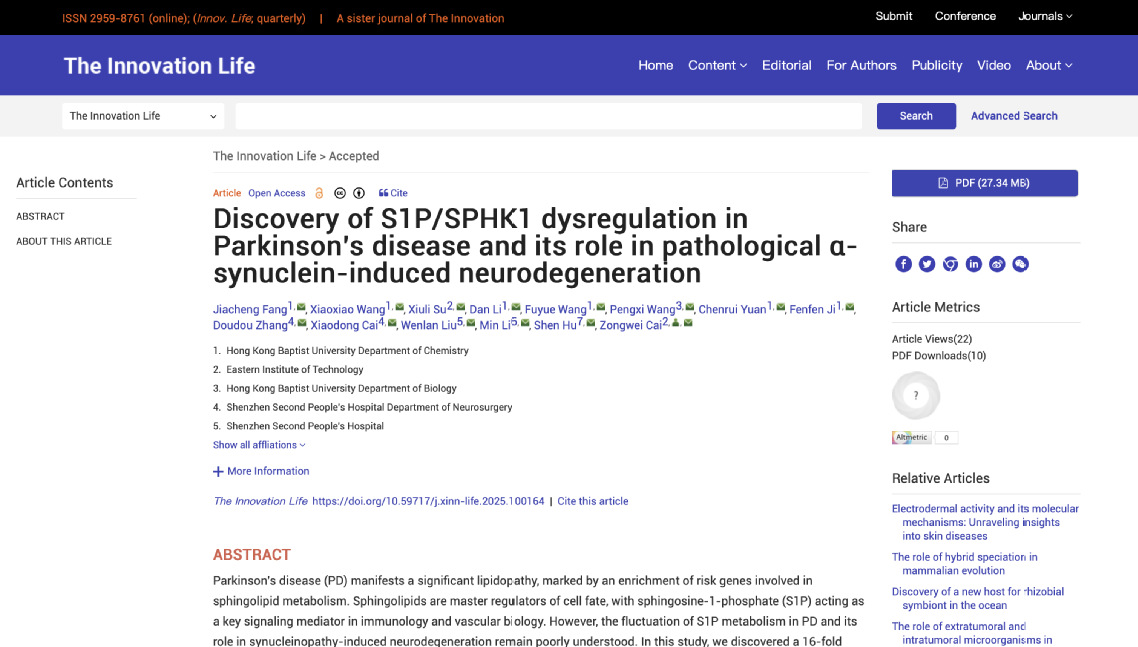A team led by Chair Professor Zongwei Cai at Eastern Institute of Technology, Ningbo has discovered a significant elevation of sphingosine-1-phosphate (S1P) levels in the cerebrospinal fluid (CSF) of Parkinson's disease (PD) patients. This alteration is closely associated with the regulation of its "upstream switch," sphingosine kinase 1 (SPHK1). Further research suggests that S1P plays a critical role in amplifying neuroinflammation and facilitating the pathological aggregation of α-synuclein, providing a novel basis for exploring new intervention strategies for PD. The related findings were recently published in the journal The Innovation Life.

Parkinson's disease is a chronic, progressive neurodegenerative disorder primarily affecting the elderly population, for which effective disease-modifying therapies are still lacking. Pathological α-synuclein is a key causative protein in PD. Its persistent deposition within neurons can trigger chronic neuroinflammation and drive the occurrence of neuronal damage.
PD is associated not only with neurotransmitters but also involves complex imbalances in lipid metabolism. In recent years, genetic and omics studies have indicated a close link between sphingolipid metabolism and PD; however, how key molecules participate in the disease process has remained unclear. Why S1P? Tracking this overlooked lipid clue from clinical patients to animal models, Professor Zongwei Cai's team connected the hidden pathway linking the amplification of neuroinflammation and α-synuclein aggregation.

Sphingosine-1-phosphate couples neuroinflammation with pathological α-synuclein aggregation in Parkinson's disease | Image provided by the research team
While previous studies often reported decreased plasma S1P levels in PD patients, Professor Zongwei Cai's team, for the first time, identified a nearly 16-fold abnormal increase of S1P in the CSF. Furthermore, S1P levels showed a significant positive correlation with the severity of motor and behavioral deficits in PD patients. In both sporadic and transgenic PD mouse models, inhibiting the activity of the upstream enzyme of S1P through genetic or pharmacological approaches simultaneously alleviated neuroinflammation and pathological α-synuclein deposition at the whole-animal level, thereby improving multiple PD-like phenotypes (see Figure).
According to the China Parkinson's Disease Report 2025, the current number of PD patients in China has exceeded 5 million, accounting for approximately 43% of the global total. Looking ahead, further evaluation of S1P-related indicators as potential diagnostic biomarkers may aid in the early identification of high-risk individuals for PD. Concurrently, it is essential to analyze the dynamic changes of S1P-related pathways across different disease stages and explore combination strategies with other mechanism-targeted interventions, aiming to promote the clinical translation of S1P inhibitors.
Dr. Jiacheng Fang and Dr. Xiaoxiao Wang from the University of California, Davis, are the co-first authors of the paper. Chair Professor Zongwei Cai from EIT is the corresponding author.












